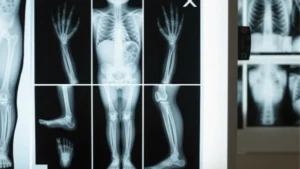Abdominal and pelvic pain can be frustrating, especially when the cause isn’t immediately clear. It could be something as simple as gas, or something more serious like a cyst, infection, or blockage. The good news? Ultrasound is one of the most effective tools doctors use to get to the bottom of it quickly and safely.
Let’s explore how ultrasound detects pelvic pain, what it can detect, and when it might be the right choice to help diagnose abdominal and pelvic pain.
What is an Abdominal/Pelvic Ultrasound?
An abdominal or pelvic ultrasound is a non-invasive imaging test that uses high-frequency sound waves to create real-time images of your internal organs. It helps doctors assess the liver, gallbladder, kidneys, bladder, uterus, ovaries, prostate, and other soft tissues.
Ultrasound for abdominal pain is especially helpful when symptoms like cramping, bloating, or sharp pain need further evaluation. It doesn’t require radiation and can often be done in a clinic or outpatient setting.
Common Causes of Abdominal & Pelvic Pain Diagnosed by Ultrasound

When someone comes in with persistent lower torso pain, ultrasound is often the first imaging test doctors turn to. It’s fast, non-invasive, and provides detailed images that help pinpoint the cause. From gallstones to reproductive issues, ultrasound can uncover a wide range of problems without the need for surgery or radiation.
Let’s take a closer look at what it can detect when evaluating both abdominal and pelvic pain.
Abdominal Pain
Pain in the upper or lower abdomen can have many sources, some minor and others more serious. Ultrasound helps narrow it down by giving a clear view of the organs inside your abdominal cavity.
Gallstones & Gallbladder Inflammation
Gallstones are hardened deposits that can form in the gallbladder and block the flow of bile. This often causes sharp pain in the upper right side of the abdomen, especially after eating. Ultrasound is the most common way to detect these stones and can also reveal signs of cholecystitis, or inflammation of the gallbladder.
Kidney Stones & Infections
Pain that radiates from the back to the abdomen may be due to kidney stones or infections in the urinary tract. Ultrasound helps spot these stones early and shows swelling in the kidneys or ureters, which often signals a blockage or infection.
Liver Conditions
If there are concerns about liver disease, such as fatty liver, hepatitis, or an enlarged liver—ultrasound provides a clear image to help assess size, shape, and possible abnormalities. It’s a helpful first step before more specialized imaging or blood tests.
Appendicitis
In certain groups, like children, teens, and pregnant women, ultrasound is used to check for appendicitis. It can show swelling or fluid around the appendix, helping doctors make a diagnosis without exposing the patient to radiation from a CT scan.
Hernias & Intestinal Blockages
When there’s unexplained abdominal pain, vomiting, or visible swelling, an ultrasound can help detect a hernia or a blocked section of intestine. These issues can be serious if untreated, and ultrasound provides a safe, fast way to check.
Pelvic Pain (Women & Men)
Pelvic pain can be linked to reproductive organs, the urinary tract, or surrounding tissues. Ultrasound is particularly effective for evaluating the pelvic area in both men and women.
Ovarian Cysts & Torsion
In women, pelvic ultrasound is one of the main tools for diagnosing ovarian cysts or fluid-filled sacs on or in the ovary. It can also detect ovarian torsion, a rare but painful condition where the ovary twists and cuts off its blood supply. These issues often cause sudden, severe pain and require quick diagnosis.
Uterine Fibroids & Endometriosis
Fibroids are noncancerous growths in the uterus that can lead to heavy periods and pelvic pressure. Ultrasound shows their size, number, and location. Though endometriosis is harder to see on imaging, ultrasound can detect structural changes or cysts associated with it, offering valuable clues for diagnosis.
Ectopic Pregnancy & Pelvic Inflammatory Disease (PID)
An ectopic pregnancy, where a fertilized egg implants outside the uterus, can be life-threatening. Ultrasound is the primary tool for detecting this early. It also helps confirm cases of PID, a serious infection of the reproductive organs that may cause long-term damage if untreated.
Prostate Issues & Bladder Abnormalities (in Men)
In men, pelvic ultrasound can assess prostate size and detect signs of inflammation or growth. It’s also useful for checking bladder function, looking for abnormalities, or ruling out obstructions that could be causing pain or difficulty urinating.
Benefits of Using Ultrasound for Diagnosis
Ultrasound offers many advantages, especially when patients need quick, accurate answers.
Non-Invasive & Painless
Ultrasound doesn’t involve any needles, incisions, or uncomfortable equipment. A small handheld device (called a transducer) is simply passed over your skin with a little gel, capturing images from beneath the surface. The entire process is gentle and easy, making it ideal for patients of all ages.
No Radiation
Unlike CT scans or X-rays, ultrasound uses high-frequency sound waves instead of radiation. That makes it a safer choice for individuals who should avoid radiation exposure, including children and pregnant women. It’s also a great option for routine monitoring of chronic conditions that may require frequent imaging.
Real-Time Imaging
One of the biggest advantages of ultrasound is that it shows live images. This allows healthcare providers to see organs and blood flow in motion, which can be especially helpful for identifying inflammation, blockages, or abnormal growths. It also helps doctors react quickly to what they’re seeing during the scan.
Cost-Effective & Widely Available
Ultrasound is typically less expensive than other imaging tests like MRIs or CT scans, and it’s available in most outpatient clinics and diagnostic centers. You won’t need to schedule it weeks in advance, and results can often be shared soon after the scan. That makes it both convenient and budget-friendly for patients and providers.
Helps Guide Biopsies or Other Procedures
If a scan reveals something unusual, like a lump or fluid build-up, ultrasound can be used to guide a needle precisely to the right spot during a biopsy or drainage procedure. This improves the accuracy of sampling and minimizes the risk of damaging nearby tissue.
What to Expect During an Abdominal/Pelvic Ultrasound

If your provider recommends an abdominal ultrasound for pain or a pelvic ultrasound diagnosis, here’s what the process looks like:
Preparation
You may be asked to fast for several hours or arrive with a full bladder, depending on which area is being scanned.
Procedure Steps
You’ll lie on an exam table, and a technician will apply a clear gel to your abdomen or pelvic area. Then, they’ll glide a small probe across your skin to capture images.
Duration
Most scans take about 20–30 minutes. It’s quick, and you can return to your day right after.
After the Scan
There’s no downtime, and your doctor will usually follow up with results shortly after to discuss next steps if needed.
When Should You Get an Ultrasound for Pain?
We all experience aches and cramps from time to time, but some symptoms shouldn’t be brushed off. If the discomfort sticks around or keeps returning, it might be your body’s way of telling you something more serious is going on.
Persistent or Recurring Pain
If your pain lasts for several days or comes and goes frequently without a clear cause, it’s a good idea to get it checked out. Ongoing abdominal or pelvic pain can point to issues like inflammation, cysts, or blockages—many of which are easily identified with an ultrasound.
Unexplained Bloating or Swelling
Feeling unusually bloated or noticing visible swelling in your lower abdomen could mean there’s a buildup of fluid, a growing mass, or digestive trouble. An ultrasound can help pinpoint the source quickly and guide your next steps.
Changes in Urinary or Bowel Habits
If you’re going to the bathroom more or less than usual, or you’re experiencing discomfort while doing so, that’s another sign that something might be off. Ultrasound is a useful tool for checking the bladder, kidneys, and other nearby structures to spot possible causes.
For Women: Irregular Menstrual Cycles or Reproductive Concerns
In women, irregular periods, unusual pain during menstruation, or suspected pregnancy issues can signal a range of conditions, from fibroids to ectopic pregnancy. A pelvic ultrasound offers a closer look at the uterus, ovaries, and surrounding areas to rule out or confirm potential problems.
If you’re dealing with any of these symptoms, diagnosing abdominal pain with ultrasound could bring much-needed clarity and peace of mind. It’s a safe and reliable way to uncover what’s going on beneath the surface.
Find Answers Faster with One Step Diagnostic

When you’re dealing with abdominal or pelvic pain, the waiting and wondering can often feel worse than the symptoms themselves. That’s why getting the right diagnosis quickly matters.
Ultrasound is one of the safest and most effective tools doctors rely on when it comes to diagnosing abdominal pain and pelvic pain, and the team at One Step Diagnostic is here to make that process easier for you.
Our advanced facilities and experienced staff provide high-quality abdominal ultrasound for pain and pelvic ultrasound diagnosis, helping physicians detect a wide range of conditions in a safe, non-invasive way. With several convenient locations, fast scheduling, and a reputation for compassionate service, One Step Diagnostic gives you access to the care and clarity you need.
If you’ve been experiencing ongoing pain, discomfort, or symptoms that don’t feel quite right, don’t wait. Reach out today or explore our diagnostic imaging services to schedule your visit.




